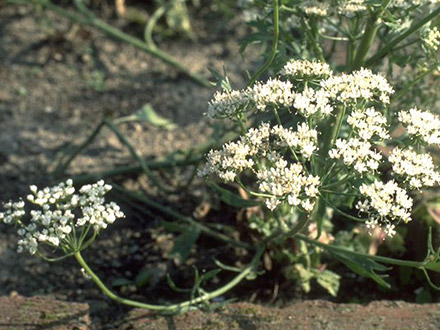Botanical name
Pimpinella anisum L.
Illicium verum Hook. f.
Family
Apiaceae (P. anisum)
Schisandraceae (I. verum)
Common name
Anise, Aniseed
Star anise, Chinese anis
Information about the plant
Anise, which is valued for its spicy aroma, probably originated in the Orient. Today, it is cultivated in Southern Europe, the Mediterranean region, the Middle East, and India. It can be found growing wild from discarded fruit on roadsides and rubble areas.
“Pimpinella" is translated into German as "Pimpernell(e)" or "Bibernelle", the latter a name found in the plant names "Große Bibernelle" (Pimpinella major Huds.) and "Kleine Bibernelle" (Pimpinella saxifraga L.). However, "Bibernelle" is also the name of the Small burnet, also known as Salad burnet (Sanguisorba minor Scop.), which is why there is often confusion between these plants.
Anise is an annual plant, it grows 30 to 50 cm high and blooms in July/August with numerous small white flowers arranged in 7- to 17-rayed double umbels. The leaves at the base of the tender stem are petiolate and rounded, becoming increasingly pinnately lobed towards the top, and attached directly to the stem. The fruits, which are greyish brown when ripe, are 3 to 5 mm long with lighter, slightly angularly prominent edges. As with all umbelliferous plants, these are "double achenes", but in the case of Anise, they do not split into the two partial fruits (achenes), as is the case with caraway. Aniseed is a popular spice for pastries and for the production of alcoholic beverages (Aniseed schnapps, Pernod, pastis, ouzo).
Star anise is the name given to the star-shaped aggregate fruits of the (Chinese) Star anise tree, a tree up to 10 m tall that is cultivated in East and Southeast Asia (China, Japan, Vietnam, Philippines). Its fruits consist of 8 reddish-brown, boat-shaped aggregate fruits arranged in a rosette around a central axis, each containing one brown seed, sometimes absent. Star anise is popular in the kitchen to flavor mulled wine.
Medicinally used parts of plants (herbal drug)
The dry, ripe 2-part schizocarp fruits (Aniseed - Anisi fructus) with their typical anise aroma, which is clearly perceptible when crushed, are used. It is caused by the essential oil contained in the fruits. The Anise available on the market comes from Turkey, Egypt and Spain.
The essential oil (Anise oil - Anisi aetheroleum), which is obtained from Aniseed fruits by steam distillation, is also used. The (genuine) Anise oil is a very expensive essential oil and difficult to obtain. That is why the less expensive Star anise oil from Vietnam and China, which is obtained from the fruits of the Star anise tree (Illicium verum), is usually traded under the name of “anise oil”. Its composition is very similar to (genuine) Anise oil, but it does not have the same aromatic quality. Star anise oil is also used medicinally (Star anise oil - Anisi stellati aetheroleum), as well as the dried fruits (Star anise - Anisi stellati fructus).
Constituents of the herbal drug
Aniseed contains essential oil ("anise oil") with sweet-tasting trans-anethole (main component), which is also responsible for the drug's distinctive scent; as well as fatty oil and proteins. Anise oil contains 80 to 90% trans-anethole, and it also contains estragole, anisaldehyde, and monoterpenes. Star anise contains essential oil with 85 to 95% trans-anethole, flavonoids, shikimic acid, and other phenolic carboxylic acids in the seeds’ fatty oil.
Quality of the drug
The quality of the following drugs or drug preparations is specified in the European Pharmacopoeia (Ph. Eur.):
- Aniseed (Anisi fructus)
- Anise oil (Anisi aetheroleum)
- Star anise (Anisi stellati fructus)
- Star anise oil (Anisi stellati aetheroleum)
Medical applications
Recognised medical use
ESCOP - Anise: dyspeptic complaints and mild gastrointestinal complaints such as bloating, flatulence; mild inflammation of the upper respiratory tract, as expectorant. In these indications, the effects are plausible on the basis of human experience and longstanding use.
Traditional use
The HMPC has classified Aniseed and Anise oil as traditional herbal medicinal products. Based on many years of experience, Aniseed and Anise oil can be used for symptomatic treatment of mild, spasmodic gastrointestinal complaints, including bloating and flatulence, and as an expectorant in coughs associated with colds.
Herbal drug preparations in finished dosage forms
Aniseeds in herbal tea blends. Anise oil in gastroresistant soft capsules or liquids.
Dried extract in coated tablets.
Anise is often processed in combination with other drugs that have a similar effect, such as fennel and caraway.
Dosage
Individual finished products; see patient information leaflet.
Tea infusion: drink 1 cup of warm Aniseed tea several times a day (also mixed with other drugs such as gastrointestinal tea; cough and bronchial tea).
Anise oil/Star anise oil: take 3–5 drops on a piece of sugar several times a day.
Preparation of a tea
Pour 1 to 3.5 g of freshly crushed Anise with a cup (150 ml) of hot (not boiling!) water, brew for 10 min, and strain. To increase the effectiveness, Aniseeds should be crushed or coarsely powdered before preparing the tea so that the essential oil can be released into the tea.
Notes
In the case of existing allergies to Umbelliferae (fennel, caraway, celery, coriander, or dill) or to anethole, Anise preparations must be avoided.
If Aniseed/Star anise is stored and exposed to light, trans-anethole can sometimes form “photoanethole” with estrogenic properties.
There are still no studies on the safety of Aniseed during pregnancy or lactation. As a precaution, children under the age of 12 should not take Aniseed; children and adolescents under the age of 18 should not take Anise oil/Star anise oil due to the lack of evidence and their estragole content.
Side effects
Occasional skin and respiratory allergies
Interactions
None known
References
Herbal drug monographs
Further literature
Commentary on the European Pharmacopoeia (Anis, Nr. 0262; Anisöl, Nr. 0804; Sternanis, Nr. 1153, Sternanisöl, Nr. 2108)


